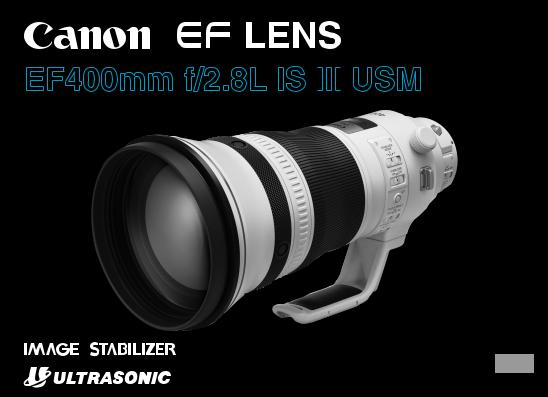Canon EF 400mm f/2.8L IS III USM User Guide

EF400mm f/2.8L IS III
 USM
USM
ENG
Instructions

Thank you for purchasing a Canon product.
Canon’s EF400mm f/2.8L IS III USM is an Image Stabilizer-equipped super-telephoto lens for use with EOS cameras.
OO“IS” stands for Image Stabilizer. OO“USM” stands for Ultrasonic Motor.
Camera Firmware
Please use the latest version of firmware with the camera in use. For details on whether the firmware is the latest version or not, and for details on updating the firmware, please check the Canon website.
Conventions used in these instructions
Warning to prevent lens or camera malfunction or damage.
Supplementary notes on using the lens and taking pictures.
ENG-1

Safety Precautions
Precautions to ensure that the camera is used safely. Read these precautions thoroughly. Make sure all details are observed in order to prevent risks and injury to the user and other people.
 Warning Details pertaining to risks that may result in death or serious injury.
Warning Details pertaining to risks that may result in death or serious injury.
OODo not look directly at the sun or other strong light sources through a lens or a single-lens reflex
camera with a lens attached. This may result in loss of sight.
OODo not leave a lens in the sun without the lens cap attached. The lens may concentrate entering sunlight
and cause a malfunction or fire.
OODo not point a lens at the sun. Even when the sun does not appear on the screen, the lens may
concentrate entering sunlight and cause a malfunction or fire.
OOWhere the lens is mounted on a camera, make sure to properly support the lens. If you hold only the camera, the lens may fall off the camera and cause a malfunction or injury.
OOBe sure to attach the included strap to the lens when carrying a camera around with the lens mounted on it. Using the strap for the camera may allow the lens to fall off the camera and cause a malfunction or injury.
 Caution Details pertaining to risks that may result in injury.
Caution Details pertaining to risks that may result in injury.
OODo not leave the product in places exposed to extremely high or low temperatures. The product may
cause burns or injury when touched.
OOOnly mount the product on a tripod that is sufficiently sturdy.
Caution Details pertaining to risks that may result in damage to property.
OODo not leave the product in excessive heat such as in a car in direct sunlight. High temperatures can cause the product to malfunction.
ENG-2
This device complies with Part 15 of the FCC Rules. |
|
|
CAN ICES-3(B)/NMB-3(B) |
||
Operation is subject to the following two conditions: (1) This |
||
|
||
|
||
device may not cause harmful interference, and (2) this |
|
|
device must accept any interference received, including |
|
|
interference that may cause undesired operation. |
|
|
Do not make any changes or modifications to the equipment |
|
|
unless otherwise specified in the instructions. If such changes |
|
|
or modifications should be made, you could be required to |
|
|
stop operation of the equipment. |
|
|
This equipment has been tested and found to comply with |
|
|
the limits for a class B digital device, pursuant to part 15 |
|
|
of the FCC Rules. These limits are designed to provide |
|
|
reasonable protection against harmful interference in a |
|
|
residential installation. This equipment generates, uses and |
|
|
can radiate radio frequency energy and, if not installed and |
|
|
used in accordance with the instructions, may cause harmful |
|
|
interference to radio communications. |
|
|
However, there is no guarantee that interference will not |
|
|
occur in a particular installation. If this equipment does cause |
|
|
harmful interference to radio or television reception, which |
|
|
can be determined by turning the equipment off and on, the |
|
|
user is encouraged to try to correct the interference by one or |
|
|
more of the following measures: |
|
|
• Reorient or relocate the receiving antenna. |
|
|
• Increase the separation between the equipment and |
|
|
receiver. |
|
|
• Connect the equipment into an outlet on a circuit different |
|
|
from that to which the receiver is connected. |
|
|
• Consult the dealer or an experienced radio/TV technician |
|
|
for help. |
|
ENG-3

General Precautions
Handling Precautions
OOIf the lens is taken from a cold environment into a warm one, condensation may develop on the lens surface and internal parts. To prevent condensation in this case, first put the lens into an airtight plastic bag before taking it from a cold to warm environment. Then take out the lens after it has warmed gradually. Do the same when taking
the lens from a warm environment into a cold one.
OOPlease also read any lens related handling precautions listed in your camera’s instruction manual.
Shooting Precautions
OOThe lens’ focusing ring is electronic.
The lens will not focus when the focusing ring is turned while the camera is turned off.
ENG-4

Nomenclature
Image stabilizer mode selector switch (→ 16) Image stabilizer switch (→ 16)
Hood mount (→ 19)
AF stop button (→ 10)
Playback ring (→ 11, 14)
Focusing ring (→ 8)
Focus preset button (→ 11)
Focus preset switch (→ 11)
Distance scale (→ 19)
Orientation locking knob
Security slot (covered) (→ 23)
Strap mount (→ 7)
Drop-in filter (→ 24)

 Lens mount index (→ 6)
Lens mount index (→ 6)

 Lens mount (→ 6)
Lens mount (→ 6)


 Contacts (→ 6)
Contacts (→ 6)

 Rubber ring (→ 6)
Rubber ring (→ 6)
Focus mode switch (→ 8)
Focusing distance range selector switch (→ 9)
Manual focus speed switch (→ 15)
Tripod mount (→ 23)
OOFor detailed information, reference page numbers are provided in parentheses (→ **).
ENG-5

1. Attaching and Detaching the Lens
Lens mount index
Lens release
button
Attaching the Lens
Align the lens mount indexes of the lens and camera, and turn the lens clockwise until you hear a click.
Detaching the Lens
Turn the lens counterclockwise while pressing the camera’s lens release button. Detach the lens once it has stopped turning.
Please refer to the camera's instructions for details.
 OOSet the camera’s power switch to OFF when attaching or detaching the lens.
OOSet the camera’s power switch to OFF when attaching or detaching the lens.
OOAfter detaching the lens, place the lens with the rear end up and attach the dust cap to prevent the lens surface and contacts from getting scratched. Make sure the lens and dust cap mount indexes are aligned when attaching the
dust cap.
OOContacts that are scratched, soiled, or have fingerprints on them may result in faulty connections or corrosion, which may lead to malfunctions. If the contacts get soiled, clean them with a soft cloth.
OOThe lens mount has a rubber ring to improve dust-resistance and water-resistance performance. This rubber ring may cause friction marks to appear around the camera’s lens mount, although this will have no effect on usage.



 OOSince the lens is heavier than the camera, turn the camera when attaching or detaching the lens. Ensuring that the lens can rest safely on its own is recommended, such as first mounting it on a tripod.
OOSince the lens is heavier than the camera, turn the camera when attaching or detaching the lens. Ensuring that the lens can rest safely on its own is recommended, such as first mounting it on a tripod.
OORubber rings can be replaced at a Canon Service Center at cost.
ENG-6

2. Attaching the Strap
Strap mount
Included strap
Thread the end of the strap through the strap mount on the lens and then back through the clasp on the strap. Pull the strap tight and check that there is no slack in the clasp.
 OOBefore using the lens, check that the strap is attached securely, that it is not worn (damaged), etc.
OOBefore using the lens, check that the strap is attached securely, that it is not worn (damaged), etc.
ENG-7

3. Setting the Focus Mode
Focusing ring
Focus mode switch
To shoot in autofocus (AF) mode, set the focus mode switch to AF.
To use only manual focusing (MF), set the focus mode switch to MF, and focus by turning the focusing ring.
See p. 14 for information on power focus (PF).
OOQuickly turning the focusing ring may result in delayed focus.
 OOThe lens’ focusing ring is electronic.
OOThe lens’ focusing ring is electronic.
OOWhen AF operation is set to [ONE SHOT], manual focus is possible after autofocusing has been completed by continuing to press the shutter button halfway (Full-time manual focus). There are times when camera setting changes are required.
OOWhen the AF button assignment is changed from the “shutter button” (using the camera’s Custom Function), manual focus is always possible regardless if the shutter button is pressed halfway any time the lens is not autofocusing.
ENG-8
